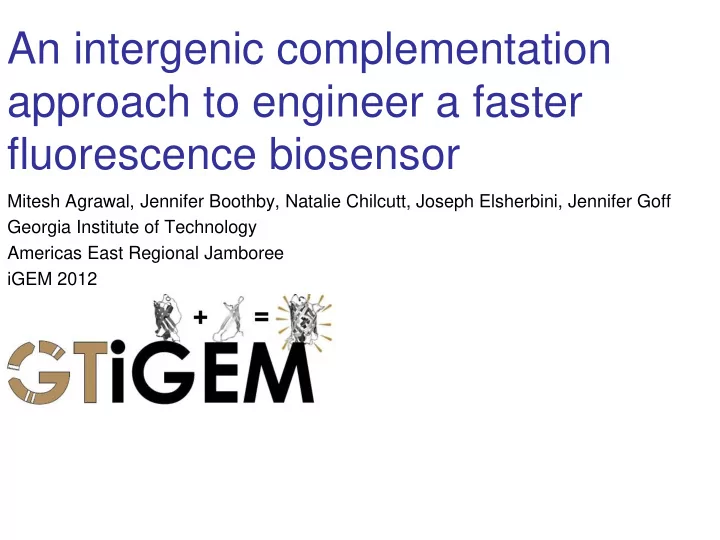

An intergenic complementation approach to engineer a faster fluorescence biosensor Mitesh Agrawal, Jennifer Boothby, Natalie Chilcutt, Joseph Elsherbini, Jennifer Goff Georgia Institute of Technology Americas East Regional Jamboree iGEM 2012
What is a biosensor? Application: Biosensor for Arsenic Signal detection as engineered by Cambridge 2009 iGEM Reporter Sensing machinery Biosensor
Quorum Sensing Signal receptor protein Signal producing Signal producing protein protein Signal Binding LOW CELL DENSITY HIGH CELL DENSITY Amount of Autoinducer
GFP Reporter Systems 1. Binding 4. Accumulation 2. Transcription 3. Translation Traditional Reporter Systems
GFP Reporter Systems 1. Binding 4. Accumulation 1. Binding 2. Dimerization 2. Transcription 3. Translation Our Novel Reporter Traditional Reporter Systems System
Our GFP reporter system 1. Binding 2. Dimerization
GFP Fragment Reassembly Barnard et. al. 2008
Agrobacterium tumefaciens
TraR dimerizes only in response to autoinducer signal AI TraR monomers TraR-AI complex
Our approach Adapted from Wilson et. al. 2004
Modeling • Factors to consider: 1) Time taken for Diffusion of Auto-Inducer across cell membrane (T1) 2) Time taken for binding of AI to the TraR protein (T2) 3) Time required for transcription + translation + accumulation (T3) 4) Time Required for the dimerization rate of GFP (T4) 5) 5000-10000 GFP molecules are required per cell for it be detected
T1 – Diffusion of autoinducer into the cell T1 calculated will be similar in both the current GFP Reporter system and our proposed GFP Reporter system. Traditional System Novel System
Number of GFP-TraR fusion proteins (i) based on TraR half-life 𝑒𝑗 𝑒𝑢 = 𝑄𝑠𝑝𝑛𝑝𝑢𝑓𝑠 𝐵𝑑𝑢𝑗𝑤𝑗𝑢𝑧 − 𝐸𝑓𝑠𝑏𝑒𝑏𝑢𝑗𝑝𝑜 𝑆𝑏𝑢𝑓. (𝑗) i = number of GFP-TraR fusion proteins Degradation Rate = ln2/ t 1/2 t 1/2 of TraR ranges from 3-680 minutes Condition: The fusion proteins have reached steady state 𝑸 ∗ 𝒖 𝟐/𝟑 𝒋 = 𝒎𝒐𝟑
Number of GFP-TraR fusion proteins based on TraR half-life Steady State Value of Fusion protein ranges from 100 – 23000 molecules/cell *The plot here shows the linear dependence of i vs TraR half-life ranging from 212-680 minutes
T2 – Binding of auto-inducer to receptor Modeled along Receptor-Ligand Kinetics Dissociation Rate Auto-inducer Binding Rate AI+TraR fusion Unoccupied Receptors complex Calculated T2 = 130 seconds Similar in both cases Traditional System Novel System
T3 – Transcription and translation Our reporter system provides an advantage over the old Reporter system Absence of Transcription+Translation after the addition of AI Translation Transcription The TraR-GFP fusion proteins are already accumulated at a steady state value (i) T3 = 0 for our system Traditional System
T3 – Accumulation of protein For the old Reporter system, it has been demonstrated that T3 = 1-3 hours To establish consistency of our model with experimental results, we modeled T3 for old system: z= number of GFP protein ; u= growth rate of bacteria; Accumulation D= degradation rate of GFP T3 (modeled) = 0.5-2 hours Traditional system
T5 – Dimerization of TraR-GFP fragment fusions T5 = 3-200 seconds depending on the steady state value of GFP-TraR Novel system
Total time taken/Conclusion Traditional GFP Reporter System Our novel GFP Reporter System T1=Similar T1=Similar T2= Similar T2= 2-3 mins = Similar T3= 60-180 mins T3= 0 (Already accumulated) T4=0 (non-existent) T4= 3-200 seconds Total time= 1-3 hours = 60-180 mins Total Time= 2-6 mins Thus, our model represents that our novel GFP reporter system reduces the time required for GFP expression by a factor of 30, supporting our hypothesis.
Results zipper-NGFP alone NGFP and CGFP zipper-CGFP alone Leucine Zipper Controls
Results • We successfully cloned TraR-NGFP and TraR- CGFP Fusions • We were unable to see fluorescent colonies on plates under many different conditions – Different concentrations of autoinducer – Different methods of induction – Growth at different temperatures
Flow Cytometry – No GFP induction Cell Count Fluorescence Level No induction of GFP fragments
Flow Cytometry – Leucine Zippers Cell Count Fluorescence Level Leucine zipper controls
Flow Cytometry – TraR-GFP fusions Frequency Fluorescence Level Experimental TraR-GFP fusions
Results- Flow Cytometry Cell Count Fluorescence Level Experimental TraR-GFP fusions
BioBricks Submitted Bba_K916000 Bba_K916001 Bba_K916002 Bba_K916004 Bba_K916003 TraR TraR-NGFP TraR - CGFP Leucine Zipper- Leucine Zipper- CGFP NGFP
BioBricks Submitted * * Bba_K916000 Bba_K916001 Bba_K916003 Bba_K916004 Bba_K916002 TraR TraR-NGFP Leucine Zipper- Leucine Zipper- TraR - CGFP NGFP CGFP
Characterizing the Las receiver BBa_K091134 • Designed by Davidson-Missouri Western 2008 iGEM team • Contains the LasR receptor from the pathogenic bacterium Pseudomonas aeruginosa with a GFP reporter • Traditional quorum-sensing-based biosensor • How part should function: – Produce LasR in the presence of IPTG – LasR binds to autoinducer – LasR + autoinducer binds to promoter – Transcription is reported by GFP expression
Sequencing of Part • The PLlac 0-1 promoter which controls the expression of lasR is completely absent. • In place of the promoter is other P. aeruginosa sequence • All other components of the part are as reported • Given the lack of the promoter for lasR expression, we anticipated that a fluorescent signal will not be produced in the presence of autoinducer
Testing of LasR Receiver • Transformed the part into E. coli • When the cells were grown in the presence of autoinducer and IPTG - + + IPTG, no AI - - + fluorescent signal was observed.
Suggestions for Improving LasR Receiver • Replace incorrect sequence upstream of lasR with the correct promoter (PLlac 0-1) • As the rest of the part appears to be as reported, this should restore the proper function to the part
Human Practices http://www.forsythnews.com/m/section/3/article/14721/
Establishing New iGEM teams
Conclusion • We submitted 5 well-characterized and documented BioBricks • We have a working mathematical model with which to test our system • We have reason to believe that our system can work with further improvements • We characterized another team’s part and improved its documentation • We helped to seed the first iGEM high school team in Georgia
Acknowledgements Dr. Clay Fuqua – University of Indiana Dr. Lynne Regan – Yale University UROP MS&T MoNaCo (NSF grant 1110947) School of Biology PURA
Recommend
More recommend